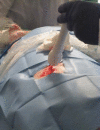Liquid Nitrogen-Based Cryoablation in In Vivo Porcine Tissue: A Pilot Study
- PMID: 33112569
- PMCID: PMC7798152
- DOI: 10.31557/APJCP.2020.21.10.3069
Liquid Nitrogen-Based Cryoablation in In Vivo Porcine Tissue: A Pilot Study
Abstract
Introduction: Liquid nitrogen-based cryoablation induces freezing evenly throughout the probe tip surface, resulting in larger ablation volumes and faster treatment times. The purpose of this preliminary investigation is to determine the efficacy of the liquid nitrogen-based Visica2 Cryoablation System (Sanarus Technologies, Pleasanton, CA) in in vivo porcine kidney, liver, and fibro-fatty tissue.
Methods: Ablations were performed under ultrasound guidance in 4 Yorkshire pigs. The target lesion cross-section width (W) and depth (D) were 1 cm for liver (n=8), kidney (n=4), and head-neck (n=5) and 2 cm for kidney (n=4). Expected axial length (L) of the resulting lesion is approximately 4 cm. After three-day survival, the ablated tissue was harvested and histologically analysed. The mean width and depth were compared with the target diameter using a one-sample t-test.
Results: All animals survived the procedure. For the 1 cm target, mean dimensions (L x W x D) were 3.8±1.5 x 1.7±0.3 x 1.7±0.7 for liver, 3.0±0.5 x 2.0±0.4 x 1.7±0.6 for kidney, and 3.3±0.8 x 1.8±0.4 x 1.8±0.4 for head-neck. Mean width and depth were significantly greater than desired dimension. For the 2 cm target, mean dimensions were 3.2±0.5 x 3.1±0.8 x 1.9±0.7. Mean width and depth were not significantly different to desired target.
Conclusion: Our preliminary results show that the Visica2 liquid nitrogen-based cryoablation system can efficiently and reproducibly create ablation volumes in liver, kidney, and fibro-fatty tissue within 4 minutes and 12 minutes for 1cm and 2cm targeted diameters, respectively. Further investigation is necessary to determine the optimal freeze-thaw-freeze protocol for larger ablation volumes.<br />.
Keywords: Cryotherapy; Liver cancer; Minimal invasive surgery; cryoablation; kidney cancer.
Figures





Similar articles
-
Hybrid radiofrequency and cryoablation device: preliminary results in an animal model.J Vasc Interv Radiol. 2004 Oct;15(10):1111-20. doi: 10.1097/01.RVI.0000136031.91939.EC. J Vasc Interv Radiol. 2004. PMID: 15466798
-
Single 15-Min Protocol Yields the Same Cryoablation Size and Margin as the Conventional 10-8-10-Min Protocol: Results of Kidney and Liver Swine Experiment.Cardiovasc Intervent Radiol. 2018 Jul;41(7):1089-1094. doi: 10.1007/s00270-018-1950-z. Epub 2018 Apr 12. Cardiovasc Intervent Radiol. 2018. PMID: 29651581
-
[Imaging and pathological features of percutaneous cryosurgery on normal lung evaluated in a porcine mode].Zhongguo Fei Ai Za Zhi. 2010 Jul;13(7):676-80. doi: 10.3779/j.issn.1009-3419.2010.07.04. Zhongguo Fei Ai Za Zhi. 2010. PMID: 20673482 Free PMC article. Chinese.
-
Needle-based ablation of renal parenchyma using microwave, cryoablation, impedance- and temperature-based monopolar and bipolar radiofrequency, and liquid and gel chemoablation: laboratory studies and review of the literature.J Endourol. 2004 Feb;18(1):83-104. doi: 10.1089/089277904322836749. J Endourol. 2004. PMID: 15006061 Review.
-
Renal cryoablation: Multidisciplinary, collaborative and perspective approach.Cryobiology. 2018 Aug;83:90-94. doi: 10.1016/j.cryobiol.2018.06.002. Epub 2018 Jun 8. Cryobiology. 2018. PMID: 29890126 Review.
Cited by
-
CT-Guided Percutaneous Cryoablation of Breast Cancer: A Single-Center Experience.Cancers (Basel). 2024 Jun 28;16(13):2373. doi: 10.3390/cancers16132373. Cancers (Basel). 2024. PMID: 39001435 Free PMC article.
-
Liquid nitrogen-based cryoablation: complication rates for lung, bone, and soft tissue tumors cryoablation.Br J Radiol. 2024 Nov 1;97(1163):1863-1869. doi: 10.1093/bjr/tqae171. Br J Radiol. 2024. PMID: 39226178 Free PMC article.
-
Pancreatic Cancer: Challenges and Opportunities in Locoregional Therapies.Cancers (Basel). 2022 Aug 31;14(17):4257. doi: 10.3390/cancers14174257. Cancers (Basel). 2022. PMID: 36077794 Free PMC article. Review.
References
-
- Bahn DK, Lee F, Badalament R, et al. Targeted cryoablation of the prostate: 7-year outcomes in the primary treatment of prostate cancer. Urology. 2002;60:3–11. - PubMed
-
- Edwards MJ, Broadwater R, Tafra L, et al. Progressive adoption of cryoablative therapy for breast fibroadenoma in community practice. Am J Surg. 2004;188:221–4. - PubMed
-
- Gage AA, Baust J. Mechanisms of tissue injury in cryosurgery. Cryobiology. 1998;37:171–86. - PubMed

